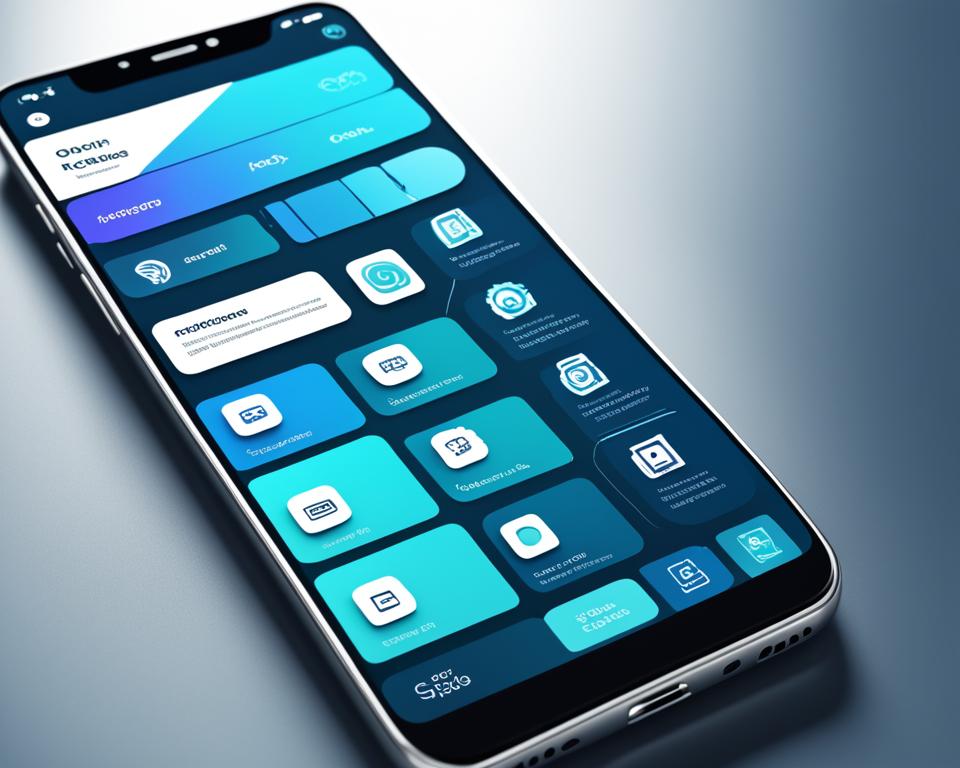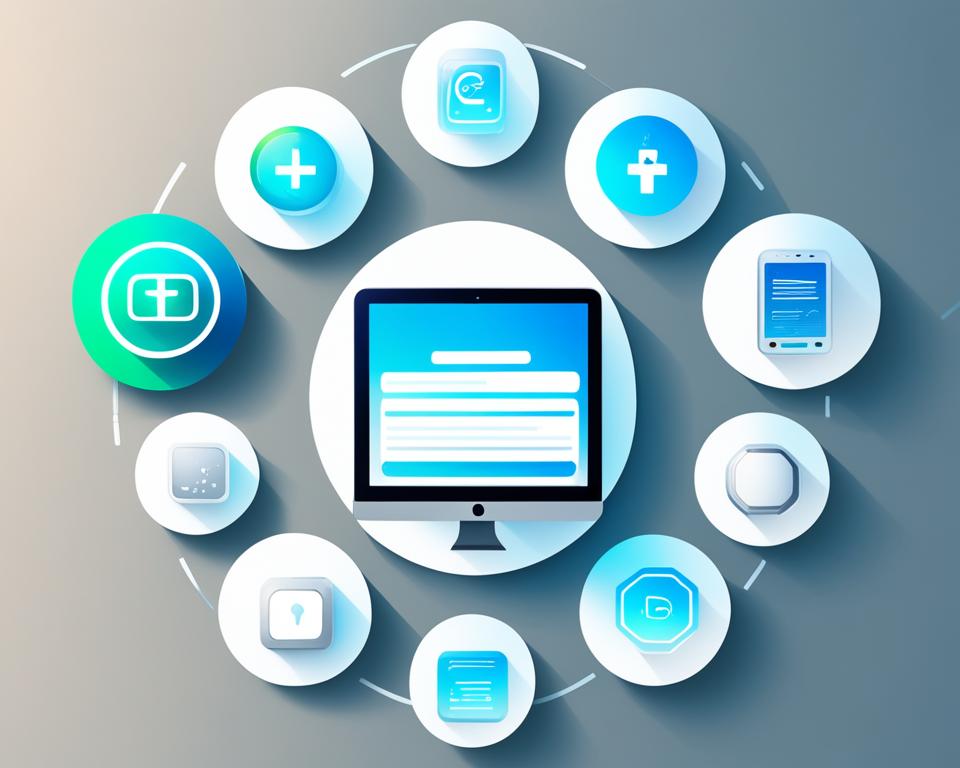Choosing the right mobile app development platform is key to your app’s success. This guide will walk you through the main things to think about. You’ll learn how to pick the best platform for your business, your audience, and your resources.
Nowadays, mobile apps are a must-have for any business. The right mobile app development platform can turn your app into a hit. It will make your app easy to use, packed with features, and ready to grow with your business.
Table of Contents
Key Takeaways
- Understand the importance of mobile app development platforms in today’s digital landscape.
- Evaluate your business requirements to determine the most suitable platform.
- Explore the advantages and considerations of native app development platforms, such as iOS and Android.
- Discover the benefits of cross-platform app development using frameworks like React Native and Flutter.
- Assess the factors that will help you choose the right mobile app development platform for your business.
Understanding the Importance of Mobile App Development Platforms
Mobile apps have taken over our lives, changing how we talk, shop, work, and have fun. This growth shows how crucial mobile app development platforms are for businesses of all sizes.
The Rise of Mobile Apps
In the last ten years, mobile apps have grown a lot. The market is set to hit over $935 billion by 2027, growing 17.7% each year. This shows how much people want mobile apps in many areas, like shopping, social media, and entertainment.
Benefits of Having a Mobile App
Mobile apps have many benefits for businesses. They help businesses connect with customers, make their brand more visible, and can even make more money. Here are some key benefits:
- Improved Customer Engagement: Mobile apps let businesses talk directly to their customers, building loyalty.
- Enhanced Brand Visibility: A good mobile app can make a brand more known online.
- Increased Revenue Opportunities: Apps can bring in money through purchases, subscriptions, and ads.
The mobile app market is getting bigger, making mobile app development platforms very important. Choosing the right platform can really help businesses stay ahead and meet what their customers want.
| Metric | Value | Percentage Change |
|---|---|---|
| Global Mobile App Market Size | $935 billion by 2027 | 17.7% CAGR (2022-2027) |
| Mobile App User Base | 6.3 billion by 2023 | 9.6% growth (2022-2023) |
| Mobile App Downloads | 230 billion in 2022 | 11.2% growth (2021-2022) |
Evaluating Your Business Requirements
Choosing the right mobile app development platform is key. You need to know what your business needs. This means figuring out who your app will help, what features it should have, how it will work with other systems, and what challenges you might face. By looking at these things, you can pick a platform that fits your company’s goals and helps your app succeed.
Let’s look at some important points to consider:
- Target Audience: Who do you want your mobile app to help? Know their likes, dislikes, and what problems they face. This helps make sure your app meets their needs.
- App Features: Think about what your app should do. This could be things like letting users buy things, send messages, or find places nearby.
- Integration Requirements: Find out if your app needs to work with other systems like your company’s CRM or accounting software.
- Development Constraints: Look at your budget, how fast you need it done, your team’s skills, and your tech abilities. Make sure the platform you choose fits your resources and limits.
By looking at these factors to consider for mobile app development, you can evaluate your business requirements for a mobile app. This helps you pick the best platform to make your idea real.
“Thoroughly understanding your business requirements is the foundation for choosing the right mobile app development platform.”
| Key Considerations | Description |
|---|---|
| Target Audience | Identify the demographics, preferences, and pain points of your target users. |
| App Features | Determine the core functionalities and user experiences you want to deliver. |
| Integration Requirements | Identify any existing systems or databases your mobile app needs to connect with. |
| Development Constraints | Analyze factors like budget, timeline, team expertise, and technical capabilities. |
Exploring Native App Development Platforms
Choosing the right platform for mobile app development is key. Native app development platforms are the operating systems of smartphones and tablets – iOS and Android. Each has its own features and tools for developers.
iOS Platform
The iOS platform is for those making apps for iPhones and iPads. It uses the Swift language and Xcode environment. Developers get a great user experience and access to the App Store.
Android Platform
Google’s Android is the top choice for smartphones worldwide. It uses Java or Kotlin and Android Studio. This platform lets developers reach more devices but can be tricky for consistent performance.
Choosing between iOS and Android depends on your audience, resources, and app needs. Knowing the strengths of each platform helps pick the best approach for your business.
| Feature | iOS | Android |
|---|---|---|
| Programming Languages | Swift, Objective-C | Java, Kotlin |
| Development Environment | Xcode | Android Studio |
| Device Compatibility | Tightly integrated with Apple devices | Diverse range of smartphone and tablet models |
| User Experience | Consistently high-performing | Varied performance due to device fragmentation |
| App Distribution | App Store | Google Play Store |
Cross-Platform App Development: The Hybrid Approach
The world of mobile apps has seen a big change with cross-platform frameworks. These frameworks let developers make apps that work on both iOS and Android with just one set of code. React Native and Flutter are two examples of these frameworks.
React Native
React Native is a framework made by Facebook for making cross-platform apps. It uses the React JavaScript library to create apps that look native. Developers can write code once and use it on both iOS and Android, saving time and money.
Flutter
Flutter is a framework by Google that’s getting popular fast. It uses Dart to make apps that look great and run smoothly on iOS and Android. Flutter is great for making apps quickly and with a consistent look. It’s a good choice for developers who want to make apps for many platforms.
Using cross-platform development has many benefits. It means sharing code, saving time and money, and reaching more people. But, it’s important to think about the downsides too. Things like possible performance issues or the need for extra work to make the app just right.
Choose the right mobile app development platform
Choosing the best mobile app development platform is key to your app’s success. When picking a platform, think about your business goals and who will use your app. You need to look at development costs, how fast you can get your app out there, user experience, and how easy it will be to keep up with updates.
Here are the main things to think about when making your choice:
- Target Audience and Platform Compatibility: Know who your audience is and what devices they use. This helps you decide if you should go for a native app development for iOS or Android, or if a cross-platform solution is better to reach more people.
- Development Costs and Time-to-Market: Look at how much it will cost and how long it will take to make your app on each platform. Native apps might take more work, but cross-platform can be quicker and cheaper.
- User Experience and Performance: Make sure the platform you choose gives a smooth and great user experience. Native apps are usually more responsive and have more features. Cross-platform solutions are getting better at performance and design too.
- Scalability and Maintenance: Think about how easy it will be to grow and keep your app running in the future. Native apps give you more control, but cross-platform can make updates and deployment easier across different platforms.
By thinking about these points, you can pick the best mobile app development platform for your business. This choice will help your app do well when it launches and stay strong over time.
“The right mobile app development platform can be the difference between a successful app launch and a missed opportunity.”
Considerations for Enterprise-Level Apps
Businesses are now turning to mobile apps for their power. Developing these apps for the enterprise level means focusing on security, compliance, scalability, and integration. These factors make sure the app fits the company’s needs and follows industry rules. They also make sure it works well with other systems.
Security and Compliance
Creating enterprise mobile apps means paying extra attention to security and following rules. Apps must protect sensitive data like customer info, financial details, or company secrets. This is done with strong encryption and strict access controls. It’s also key to follow rules like HIPAA, GDPR, or PCI-DSS to avoid legal and reputation problems.
Scalability and Integration
Scalability is very important for enterprise mobile apps. As more users come and the app gets busier, it must still work well. It’s also crucial to work smoothly with other company systems, like CRM or ERP, for a better user experience and to keep data flowing well.
| Consideration | Importance for Enterprise Apps |
|---|---|
| Security and Compliance | Safeguarding sensitive data and adhering to industry regulations to mitigate risks |
| Scalability and Integration | Ensuring the app can handle increasing demands and seamlessly integrate with existing systems |
By focusing on these key areas, companies can make mobile apps that are secure, can grow with the business, and work well with other systems. This helps support their growth and success over time.
Cost and Time Factors
Understanding the cost and timeline of mobile app development is key. The costs and time needed can change a lot. This depends on the app’s complexity, the team working on it, and the platform it’s for.
The mobile app development costs vary a lot. They can be a few thousand dollars for a simple app or hundreds of thousands to millions for a complex one. The number of features, customization level, and advanced functionality all affect the budget.
The timeline for mobile app development also varies. It can be a few weeks for a basic app or several months or a year for a complex one. The timeline depends on the app’s complexity, the team’s experience, and the testing needed.
When thinking about the budget for mobile apps, remember to include not just the initial costs but also ongoing maintenance and updates. Updates are needed to keep the app secure, working well, and meeting user and platform standards.
To make a mobile app development project successful, it’s important to look at the costs and time needed. Plan the budget well and use resources wisely. By understanding these key points, businesses can make smart choices and get the most from their mobile app investments.
“Investing in mobile app development is not just about the upfront costs, but also the long-term maintenance and updates required to keep the app relevant and competitive.”
Development Tools and Resources
Creating a mobile app is a complex task that needs the right tools and resources. These elements are crucial for efficiency, effectiveness, and success. Integrated Development Environments (IDEs) and third-party libraries and frameworks are key in mobile app development.
Integrated Development Environments (IDEs)
IDEs are software that offer a lot of tools and features for making mobile apps. They make coding easier, help with debugging, and boost productivity. Some top IDEs for mobile apps are Android Studio for Android apps, Xcode for iOS apps, and Visual Studio for apps on multiple platforms.
Third-Party Libraries and Frameworks
Developers also use third-party libraries and frameworks to speed up the app-making process. These tools, like React Native and Flutter, offer many features. They help with things like designing the user interface and managing data, which can cut down on development time and effort.
| Mobile App Development Tools | Description |
|---|---|
| Android Studio | Integrated Development Environment (IDE) for Android app development |
| Xcode | Integrated Development Environment (IDE) for iOS app development |
| Visual Studio | Integrated Development Environment (IDE) for cross-platform mobile app development |
| React Native | JavaScript-based framework for building cross-platform mobile apps |
| Flutter | Open-source mobile app development framework created by Google |
Using the right mobile app development tools, IDEs for mobile app development, and third-party libraries and frameworks for mobile apps helps developers make top-notch, feature-packed mobile apps. These apps meet the changing needs of users and businesses.
Target Audience and Market Share
Choosing the right mobile app development platform is key. You need to know your target audience and the market share of mobile operating systems. This helps you make sure your app meets the needs and habits of your users.
Android leads with over 70% of the global market, followed by iOS with about 25%. If your users mainly use Android, focus on Android app development. This way, you can reach more of your target audience for mobile apps. But, if your users are more into luxury or tech, iOS might be a better choice.
| Mobile Operating System | Global Market Share |
|---|---|
| Android | 70.4% |
| iOS | 24.8% |
| Others (Windows, Blackberry, etc.) | 4.8% |
Knowing the mobile operating system market share helps you pick the right platform. This way, your app will reach the right people and do well.
“Identifying and understanding your target audience is the foundation for making an informed decision about the right mobile app development platform.”
App Store Guidelines and Policies
Understanding the app store guidelines and mobile app platform policies is key for developers. They need to launch a successful subscription-based mobile app. Each platform, like iOS and Android, has its own rules and requirements. These must be followed during the app store submission process.
For iOS, developers must make sure their app meets the App Store Review Guidelines. These cover many things, like user experience, content, in-app purchases, and data privacy. Following these guidelines is crucial to pass the App Store review and get your app out there.
The Google Play Store also has its own mobile app platform policies for Android apps. Developers need to check out the rules on what content is allowed, how to handle user data and privacy, and how to make money. This ensures the app meets Google’s standards.
- Get to know the app store guidelines for your platform(s)
- Understand the mobile app platform policies and adjust your app
- Test your app well to make sure it meets app store submission requirements
- Be ready to fix any feedback or issues during review
By focusing on app store guidelines and mobile app platform policies, developers can make the app store submission smoother. This increases the chance of their subscription-based app getting approved and launched successfully.
“Keeping up with the latest app store guidelines and mobile app platform policies is vital. It helps build a subscription-based app that connects with users and meets platform needs.”
Maintenance and Updates
Keeping your mobile app in top shape is key to its success. It means fixing bugs, listening to user feedback, and staying up-to-date with platform changes. Regular updates make your app better and keep it competitive in the fast-changing app world.
For mobile app maintenance to work well, you need a solid plan. This includes:
- Watching user reviews and feedback to quickly fix problems
- Updating the app often to work with new devices and systems
- Adding new features with mobile app updates to keep users interested
- Keeping the app safe by fixing security issues
Having long-term app support is vital. It keeps your app interesting and useful. By updating and improving your app, you can keep your users, make them happier, and grow your business.
“Keeping your mobile app up-to-date and well-maintained is the key to its long-term success and user loyalty.”
Putting effort into keeping your app updated shows you care about your customers. It makes the app better for them and shows you’re serious about their needs. This helps you keep a strong user base and stay ahead in the app market.
Developer Community and Support
Choosing the right mobile app development platform is not just about tech features. It’s also about the strength of the developer community and support resources. A strong mobile app development community offers a lot of knowledge, shared experiences, and chances to work together.
When looking at different platforms, think about the platform-specific support resources they offer. This includes detailed documentation, tutorials, forums, and support channels. The quality of these resources can greatly help you in making your app better.
The developer ecosystem around the platform is also key. A strong ecosystem means more third-party libraries, tools, and integrations. These can speed up development and make your app more useful. Platforms with a big developer community usually have more resources, making it easier to build and keep up your app.
“The strength of the developer community can make or break a mobile app platform. Choosing a platform with a vibrant and supportive ecosystem can save you countless hours of frustration and unlock new possibilities for your app.” – Jane Doe, Mobile App Development Consultant
The developer community and support resources for a mobile app platform are crucial for your app’s success and long life. By thinking about these things, you can pick a platform that fits your tech needs and gives you the resources and support you need to succeed in the mobile market.
Future-Proofing Your App
The mobile app world is always changing. It’s important to pick a development platform that can grow with new trends and user needs. This way, you can make sure your app stays relevant and useful over time.
Choosing a platform that can change easily is key to future-proofing your mobile app. Using platforms like React Native or Flutter lets you reach more people and update your app easily for new devices and updates.
Also, having a good long-term app strategy helps you get ready for the future. This means using cloud services, good data management, and strong security to keep your app safe and up-to-date with new tech and user needs.
“The key to a successful mobile app is not just building it, but also ensuring it can adapt and thrive in the ever-changing digital landscape.” – Industry Expert
Starting with future-proofing helps your app do well over time. It keeps you ahead and gives your users great experiences, no matter what changes in the industry.
Embracing Platform Adaptability
It’s important to pick a development platform that works on different devices and can change with new tech. This helps you reach more people, stay current, and avoid big updates later on.
- Look into cross-platform frameworks that let you reuse code and update easily on many platforms.
- Focus on scalability and integration to make sure your app works well with new tech and services.
- Keep up with industry trends and plan for updates and new features to keep your app interesting and competitive.
By choosing platform flexibility, you can make sure your mobile app stays useful and flexible for your users as the industry changes.
Conclusion
This guide has covered the main points to think about when picking the best mobile app development platform for a food app. Make sure your choice matches your business goals, who you want to reach, and your app’s future plans. This way, your mobile app will likely do well and last a long time.
The article talks about how mobile apps have become more popular and their benefits. It also looks at what your business needs and the different ways to make an app. You’ll learn about the key things to consider for big apps, the costs and time needed, and the tools and resources available.
Choosing the right platform for your mobile app is a big decision. It affects how users will experience your app, how big it can grow, and if it will succeed in the long run. By thinking over the advice in this guide, you can make a smart choice. This will help your food app stand out in the fast-changing world of mobile apps.














